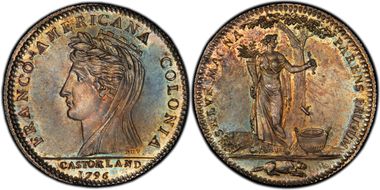1796 AR Medal Castorland, Original XF40 认证号06915056, PCGS号653
专家评论
Ron Guth
1796 Castorland Jetons were given to board members of the company that oversaw a French colony in New York State known as Castorland. The name of the coin derived from the beaver laying at the base of the reverse (no, it is not a dog) -- "castor" was the French word for beaver, an important source of income for early settlers of the region. Castorland Jetons are classified as Originals and Restrikes, though there is some shading of these terms, as it appears the coins given to board members were struck over several years. The "purest" Originals will have no rust at the handle on the right side of the reverse, nor will they have even the faintest whisper of a crack at the S of PARENS. Later states begin to rust at the pot handle, then begin to crack at the S. Eventually, the crack leads to wide and extensive sinking of the die in the right reverse field. Where to place the line between Original and Restrikes is problematic, but PCGS recognizes both non-rusted and rusted examples as Originals. Any coins with a crack at PARENS are considered a Restrike.
Castorland Jetons were restruck in silver, copper, and gold. Planchets range from very thin to very thick. The edges of the Originals are always reeded; restrikes come with either plain or reeded edges. Restrikes will have an edge hallmark and/or a word signalling the metal composition ("Argent" for silver or "Cuivre" for copper). Curiously, the edge markings are almost always positioned perfectly on the edge below the beaver. The Paris Mint still produces Castorland Jetons for collectors, but their style and finish is completely different from that of the Originals.
Silver Originals are among the most underrated of all American "Colonials," primarily because of the lack of informaiton concerning them.





















